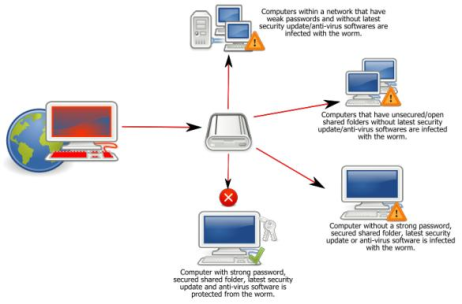World’s Most Stunning Data Centers

Who says there can’t be any art in technology? Here I present, some visuals of the most expensive data centers in the world.
Pictured above and below, its the Microsoft’s top-secret data center – it surely is a piece of Art. Physically real, yet still beautiful !

Sweden’s Largest ISP:
This underground data center has greenhouses, waterfalls, German submarine engines, simulated daylight and can withstand a hit from a hydrogen bomb. It looks like the secret HQ of a James Bond villain.
And it is real. It is a high-security data center run by one of Sweden’s largest ISPs, located in an old nuclear bunker deep below the bedrock of Stockholm city, sealed off from the world by entrance doors 40 cm thick (almost 16 inches).




And here is what it used to look like:

Quite a difference, isn’t it? ![]()
Secure Yourself Against Conficker Worm
Windows OS users across the globe have been worried sick about the Conficker worm striking back on April 1,09.
Anti-virus and security solutions providing companies like Symantec, F-Secure, Avast! and others are however singing a relieved tune. That’s because they say they’re prepared to tackle it.
What’s this Conficker worm anyway?
The ‘C’ variant of Conficker worm, aka Downadup or Kido, infects Windows machines (XP and Vista) and disables them to get security updates or patches from Microsoft and from other vendors. According to Symantec, the creators of the worm will also start using a communications system that is more difficult for security researchers to interrupt.

(Image source: Wikimedia)
How will Conficker harm users?
While nobody knows what exactly Conficker will actually do, most likely, the worm will be used to create a botnet that will be rented out to criminals who want to send SPAM, steal IDs and direct users to online scams and phishing sites.
What can be done to protect a computer from this worm?
First of all, update your anti-virus software. Especially on April 1, make sure that it’s actually running when you start your computer. Secondly, make sure that you have the latest Windows security updates.
You should know:
1. Changing the date of your system will not help avoid this worm.
2. Keeping your computer shut on April 1 will also not help either.
3. The only way to get past this worm is by updating Windows and your anti-virus software.
Conficker History
The ‘B’ variant of the Conficker worm had created ruckus around January this year. By February, it had affected over 9 million Windows users worldwide. Perturbed by the virus, Microsoft had even announced to pay reward of $250,000 to any individual who’ll find out the culprits behind Conficker.
Last words
Before this April 1 — Don’t be a fool, download the security tool.
Some resources are listed here:
http://support.microsoft.com/kb/962007
http://vil.nai.com/vil/content/v_153464.htm
http://www.411-spyware.com/conficker-worm-removal
http://community.mcafee.com/showthread.php?t=225901
Password managers keep your login info handy
From shopping to banking sites to network and to remote-access logins, we’re inundated with requests to create and remember a plethora of passwords.
Fortunately, plenty of free tools help us store and organize our passwords in a single, secure location.
If you counted the number of times you were prompted to enter a login ID and password in the course of a working day, you could be approaching double digits by your afternoon break.
Firefox, Internet Explorer, and other browsers offer to remember passwords for the sites you visit. However, your passwords are not always secure when stored in a browser though Firefox is a safer bet, since you can encrypt its passwords with a master password.
Furthermore, you might need a tool that saves passwords for other programs, not just Web sites. If you’re like me, relying on your memory is perilous, and writing your passwords on a piece of paper even one you keep in your wallet or some other relatively secure location is dangerous. That’s where password-management utilities come in.
Password managers are small databases designed to help you manage the deluge of passwords needed to navigate your computer, network, and Internet needs. With the exception of RoboForm’s browser toolbar, most of these programs have a similar interface and features, including but not limited to the following:
1. A main window showing a list of your account names, passwords, URLs, and so forth
2. Automatic password generation and optional password-expiration settings
3. An option for attaching notes to any name and password entry
4. The ability to copy a name and password to the clipboard without opening the dialog for each entry
5. A means of launching a URL from the password manager
6. A feature for clearing the clipboard and encrypting the password database
7. The ability to print the database
The most cumbersome thing about password managers is that you have to cycle through multiple windows to use them. In most cases, the scenario goes like this:
Screen 1. Select your account in the password manager window and copy the account name.
Screen 2. Switch to your browser (or other application window) and paste in your name.
Screen 3. Switch back to the password manager window and copy the account password.
Screen 4. Switch to the browser yet again to paste in the password.
KeePass, Access Manager, 4uonly, and other programs simplify this process only slightly by letting you drag and drop the information between windows. However, you still have to switch between windows repeatedly.
There are so many password managers available that I had to limit my selection to those that offer a free version and also include a wealth of features. Not all of the programs claim to run under Vista.
#1: Siber Systems RoboForm
Top choice specializes in Web access
RoboForm takes a unique approach to password management, using as its main interface a toolbar that attaches to your Internet Explorer or Firefox browser. The program monitors your Web surfing and offers to save any name and password information you enter at a site. (You can also enter your Web IDs and passwords manually.)
For some, the biggest downside to RoboForm is its Web focus. The program is designed to work with Web forms and logins, not network passwords or encrypted folders (although you can always store that info in its Safenotes feature).
The free version of RoboForm limits you to ten passcards and two identities.
#2: KeePass Password Safe
The open-source option for password management
For open-source software loyalists, KeePass Password Safe is certified by the Open Source Initiative and has all the features mentioned above plus a few extras. For example, KeePass supports keyfiles, a type of file that acts as a key or password and that you can put on a separate USB flash drive for safe-keeping. The program’s search feature helps you find entries in its database. (Access Manager also offers this feature.)
KeePass’s many features make it probably the best freeware password manager.
#3: Citi-Software Ltd. Access Manager
These extra features are worth paying for
Like RoboForm, Access Manager 2 comes in a free and paid version. The program’s main window requires that you select an account name before you see the database record listing the password and any other info you’ve entered for it. This is the only password manager with this requirement.
For each account, you can enter not only a URL but also the name of a file, folder, or program that must be unlocked with a password. You can also open such an item from the Access Manager window.
Access Manager is a solid product with strong appeal for those who use passwords for more than just Web sites. Still, you’ll need to pay if you want to use the program in a commercial setting or if you need more advanced password-management features.
#4: Cygnus Productions Password Corral
A plain-Jane password-management freebie
Password Corral is a typical freeware password manager, but unlike most such tools, the program doesn’t hide your passwords in the main window with the usual asterisks in place of the actual characters. There’s a button you can click to hide (scramble) or unhide the information in the main window, but doing so also hides the user name and URL.
Password Corral is the only password manager I know that doesn’t let you drag and drop names and passwords into the appropriate files.
#5: Dillobits Software 4UOnly
Basic password management with one big flaw
Like Password Corral, 4uonly takes a basic approach to password management, though it does let you drag and drop names and passwords, just as in other password managers.
The program does offer one time-saving feature: it protects your password database by tying it to your Windows account. So as long as you’re logged into Windows, you don’t have to supply 4uonly with a master password. However, you can still assign one in case you are logged in under other credentials.
More disturbingly is that the status bar sometimes states, “The clipboard is empty,” even when the password is still on the clipboard. The program’s command to clear the clipboard resolved this, but the misleading message is a serious security bug.
Who will win the Security National Championship?
World Security Challenge is a new online, interactive security awareness tool from Computer Security Institute that teaches security basics using the fun and fast-paced theme of a sporting competition.
The six sporting events challenge the competitors’ skills, while teaching your employees secure behaviors in six critical areas.
Six Security “Event”:
* Passwords
* E-mail Security
* Internet Security
* Social Engineering
* Workspace Security
View the Video Clip here: Security National Championship
What is Information Security ?
Information Security (Wikipedia Definition) is a broader term than IT Security or Internet Security or Enterprise Data Security.
Information Security encompasses data stored in digital fashion (electronic format), trade secrets, know-how, intellectual property rights, historical data, information on data access, policies and procedures laid down, compliance & standards established within the organization, plans and budgets, financial & management data, brochures, images, logo and designs, employee information and so on and so forth.
Information Security includes the organization’s policy on IT Security, Internet Security, Enterprise Data Security, etc.,. To put it in other words, it looks at protecting / safeguarding information and information systems from anyone including employees, consultants, suppliers, customers and of course, malicious hackers.
However, people often confuse information security with IT Security. IT Security is a term which is more concerned with the protection of hardware, software and a network of an organization, from the perils of disaster and external attacks (through virus, hacking, etc.,). It is more to do with the electronic data and is covered in the IT Policy of an organization, whereas Information Security Policy goes beyond the network and applies to the organization as a whole.
Internet Security (Wikipedia Definition) on the other side, is more concerned with the internet architecture and covers the protection required during communication between two computers over the internet / intranet.
There is also another school emerging, claiming that Information security is about securing information in the broadest sense. Information security should be governed by the exec management through goals, strategies and finally as policies. The technological side of things are left to specialists – and include physical security, logical security, HR and information management. Corporate governance and internal control are key to succeed.
Suggested Readings:
ITSecurity.com
Information Security Glossary











































